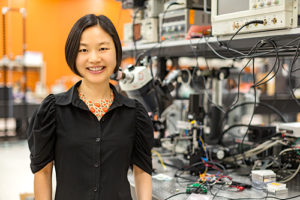THE THREE-YEAR PROJECT THAT WILL CONVEY LIGHTBORNE DATA
A torrent of information blazes past most of us unseen, at the speed of light.
It is light — traveling through fiber-optic cable, conveying data at 186,000 miles per second.
Then comes the slowdown: That light must be converted to electricity, to allow traditional hardware to use the data.
Qing Gu, assistant professor of electrical and computer engineering at the University of Texas at Dallas’ (UTD) Erik Jonsson School of Engineering and Computer Science, has launched a three-year project to research a way to develop microchips that will convey lightborne data.

At first, Gu considered using nano (i.e., tiny) lasers to do the job. Now she’s developing nanoscale light-emitting diodes (LEDs), which emit light when voltage
is applied.
Gu explains her idea this way: “Under applied voltage, electrons recombine with holes within the active region of the [experimental/theoretical] device, releasing energy in the form of photons [which make up light].”
Playing a key role in the process, according to Gu, is incorporating a “p-n junction diode,” which conducts electricity in one direction and blocks current from traveling in the opposite direction.
Her theory has captured the attention of the U.S. Department of Defense’s Army Research Office, which awarded her $356,000 to develop a nano-LED technology to be used in integrated circuits.
“This cutting-edge work with nano-LEDs could have a broad impact on the Army,” says Dr. Mike Gerhold, program manager for electronics at the Army Research Office, an element of the U.S. Army Combat Capabilities Development Command. “This research could lead to the development of low-energy data communications for faster and more energy-efficient electronic systems. Other applications would include active electro-optical systems where optical beam steering and sensing is needed.”
As Gerhold mentions above, a nano-LED would represent a significant technological advancement: When a signal comes into an electronic device via optical fiber, that light signal must be converted to an electrical signal that the device’s chips can process and then must be converted back to an optical signal to communicate information to other devices. The whole process can consume a lot of energy. Not to mention that it slows down performance.
Gu says advances in technology have set the stage for higher-speed and higher-efficiency data transfer.
“Now since we’re doing so much cloud computing, cloud storage and online video gaming, we need really fast internet speeds,” Gu said. “In order to get faster internet, we need to increase the speed of data communication on the chip.”
Getting back to nano, how tiny is that?
A single human hair can measure 80,000 to 100,000 nanometers thick. The diodes that Gu is developing measure 600 nanometers in diameter and are 1,300 nanometers in height.
In order to work at that level, Gu is collaborating with Zyvex Labs — a partner in many atomic-level UTD research projects — to use an atomically precise scanning tunneling microscope to guide the nano-LED cavity through conductive material.
“Dr. Gu’s research is looking to bring the increased data speeds down to the chip level. This is both much more difficult and much more exciting,” says Dr. Lawrence Overzet, head of the Department of Electrical and Computer Engineering at UTD. “Dr. Gu’s research is at the cutting edge of photonics, and we are excited about what she brings to electrical and computer engineering at UT Dallas.”
This article is part of the 2020 Higher Education Review Magazine.